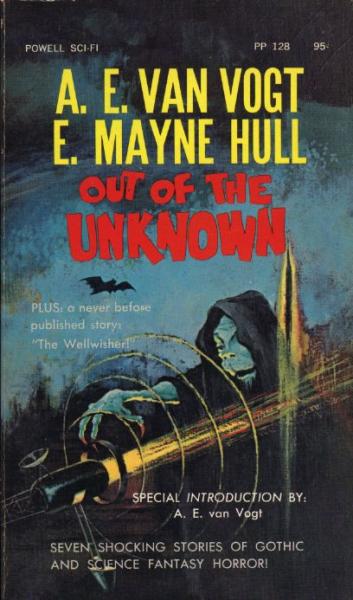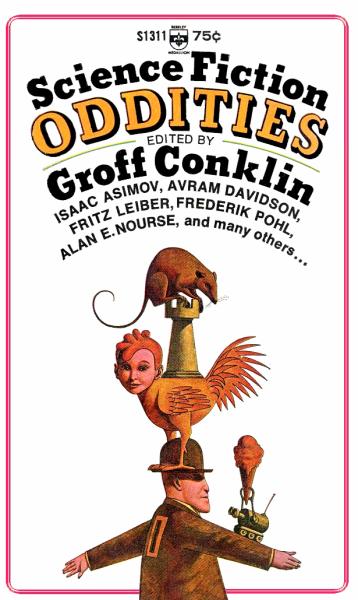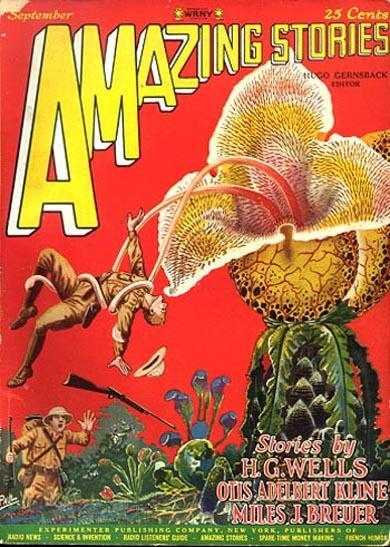My 14th Conklin item is my second 5/5 selection, Lovecraft’s “Colour Out of Space,” in The Omnibus of Science Fiction (1952). One reason I decided to reread it now was that we had news reports yesterday of a history-making and somewhat harmful meteorite in Russia. (When news reports about Pluto’s demotion to dwarf planet were issued, I marked the occasion by rereading “The Whisperer in Darkness.”)
The story begins effectively, with sentences often featuring rather noncommittal constructions. Look at how the core of many main clauses is something of this sort: there are; there are; There are; there are; these are; folk have gone; It is; place is; It must be; Ammi Pierce has never told; Ammi is; There was; people ceased; Traces can; some will linger – etc. This style would, of course, be annoying if it weren’t for the fact that one senses something like this, that the narrator is trying quite hard to avoid sensationalism or an undue emphasis on how he feels about the events he is going to describe.
The fourth through sixth paragraphs introduce the narrator’s own impressions of the unwholesome region, and here we see that Lovecraft had learned something from Arthur Machen – evident in phrase such as “dark westward tangle of glens and slopes,” “Upon everything was a haze of restlessness and oppression,” etc. (In the first paragraph, which is not presented as being specifically the first or later impressions of the narrator, we have the Machenian “think brooklets trickle without ever having caught the glint of sunlight,” etc.) I would say the first just slightly false note intrudes here, with the somewhat clichéd locals who mutter and whisper in fright. They seem like stock properties in whom Lovecraft himself doesn’t quite believe.
The tenth paragraph (“It all began”) resumes the noncommittal style: there had been, These were not, dusk was, there had come, Arkham had heard, etc. The reader accepts without question “that white noontide cloud, that string of explosions in the air, and that pillar of smoke from the valley far in the wood,” all the more if he has just seen the Russian videos!
The description in the 11th paragraph recalls the always effective – no matter how many times the novel is reread – description of the Martian cylinder that crashed onto the Surrey heath in Wells’s
War of the Worlds.
The 12th paragraph (“The day after that”) continues the firmly Wellsian style. (I should say that in suggesting Lovecraft had learned from Machen and Wells, I am complimenting him. They were two of the greatest fantasists of the generation before Lovecraft’s. Of course, they were still alive when he wrote “Colour,” but their most impressive work was largely behind them by the 1920s.) In this paragraph the “three professors” are “wise men,” and in the 14th paragraph they are “sages,” and one senses a nicely restrained sardonic quality; obviously they are puzzled, and it is taking them a while to realize the dreadful significance of what they test, seeing it right under their noses. If you blink, you miss the fact that Ammi’s wife does not come out to greet the professors on their second visit.
Paragraph 15 (“They had uncovered”) gives a nicely restrained account of a new development in the story of the meteorite, the bursting open of a bubble in it. I wondered if Lovecraft had seen geodes or “thunder eggs” as we used to call them in Oregon. I found a nice little specimen in the Buckhorn Springs Road are near Ashland while on a ramble with my dad some years ago. The picture is someone else's find:
Paragraph 16 (“Conjecture was vain”) contains a possible echo of a third master fantasist of the Wells-Machen generation, Rudyard Kipling. In his superb “Strange Ride of Morrowbie Jukes,” we read that a “little bit of the dark world came through” Jukes’s head “and pressed him to death.” Lovecraft writes that the meteorite “was nothing of this earth, but a piece of the great outside.”
Paragraph 17 (“That night”) continues to display Lovecraft’s sure handling of his materials. If the reader pauses to imagine the scene, he’ll see something sublime enough (in Edmund Burke’s sense) – the lightning striking again and again at the meteorite site, etc. But Lovecraft holds back, orchestrating his effects such that he does not indulge in a premature bit of sublimity that could deflate what’s to come.
Now Lovecraft begins the sequencing of the meteorite’s dire effects. Nahum tires more easily and assumes he is getting old (paragraph 18). In the next paragraph there may be a reminiscence of Milton’s Paradise Lost, where the fruit that Satan and his angels sample is compared to the actual “apples of Sodom,” green globular fruit, hollow and bitter:
...greedy they pluck'd
The Frutage fair to sight, like that which grew
Neer that bituminous Lake where
Sodom flam'd;
This more delusive, not the touch, but taste
Deceav'd; they fondly thinking to allay
Thir appetite with gust, instead of Fruit
Chewd bitter Ashes, which th' offended taste
With spattering noise rejected: oft they assayd
Hunger and thirst constraining...
A reminiscence of Revelation (8:11) may also appear, but here it is not waters but the soil that is poisoned by the fallen “star Wormwood.”
















